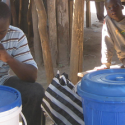Consumer perspective on traditional Mabisi

This Master thesis “Risk assessment of a traditional Zambian drink” is written by Liv van de Ven, project member of the Global Challenges Programme project on traditional fermented foods in Zambia. The Master thesis shows that consumers have a preference for traditional Mabisi should it be available on the market and proven to be safe for consumption.
Abstract
Mabisi, a fermented milk drink, is one of the traditional beverages from Zambia. The product is important as food source for many inhabitants, young to old. Regardless the importance, no safety standards and regulations are yet made to protect health of the consumers. A risk assessment is indispensable to secure consumers health. To make this assessment, three activities were designed and executed: (1) determining the safety perception of consumers and producers, (2) monitoring of the presence of pathogens and resilience of the product against selected pathogens in the product and (3) consideration and implementations to conduct a safe product. In this study we found that there is a market in the urban regions of the country for a safe traditional product. Purchase behaviour of urban citizens was linked to availability and safety concerns. The majority of the producers (8/9) saw no risk in production of traditional mabisi with concern to the consumers health. And half of all consumers (n=172) interviewed perceived the traditional product as safer compared to the commercial alternative (51%). The majority (60%) associated no risks to the consumption of the traditional product. Despite that, this study revealed that traditional methods of fermenting raw milk into mabisi in Zambia pose potential hazards to human health. Enterobacteriaceae and S. aureus were detected frequently (10 out of 14) in ready to sell products. Most products (9/10) contaminated with S. aureus did not reach the infective dose to start an infection. Samples from two producers detected for growth of Salmonella spp. with the plate count method and none of the samples detected positive on B. cereus or Shigella spp. With challenge tests we found that contamination during fermentation and during storage at refrigeration temperatures resulted in survival of food borne-pathogens. With increased fermentation temperature a decline of the pathogenic growth rate during fermentation was shown. Most producers have knowledge of critical points in the process, however it is unclear whether these steps receive the actual attention they need. To minimise the risk of food borne diseases, some approaches could be used. Some of those strategies are: implementation of a starter culture, education on food hygiene and storage for consumers, improvement of Good Agricultural Practices (GAP), Good Manufacturing Practices and (GMP) and Good Hygienic Practices (GHP) for producers and more research on critical control points and their limits.
Download the complete Master thesis “Risk assessment of a traditional Zambian drink” (PDF).






